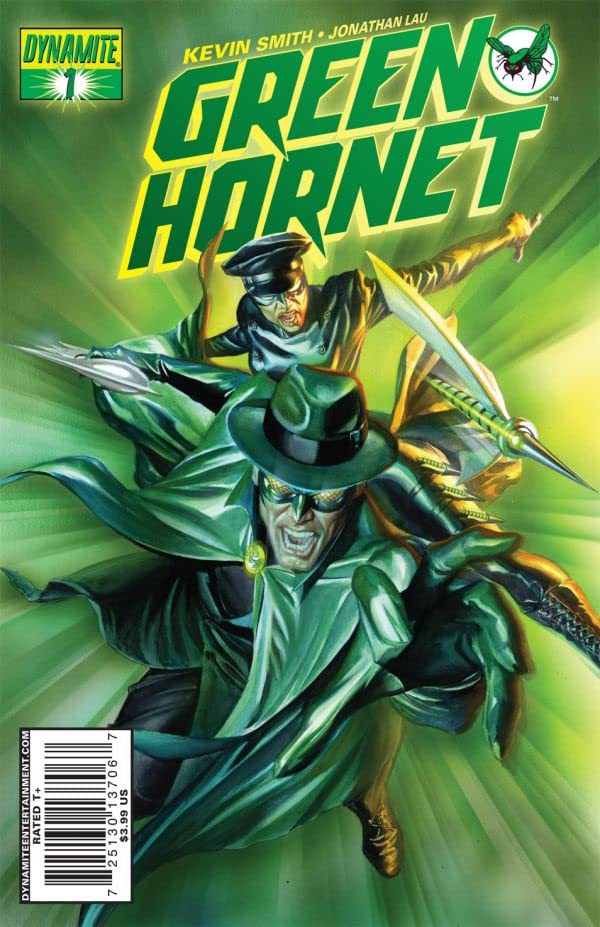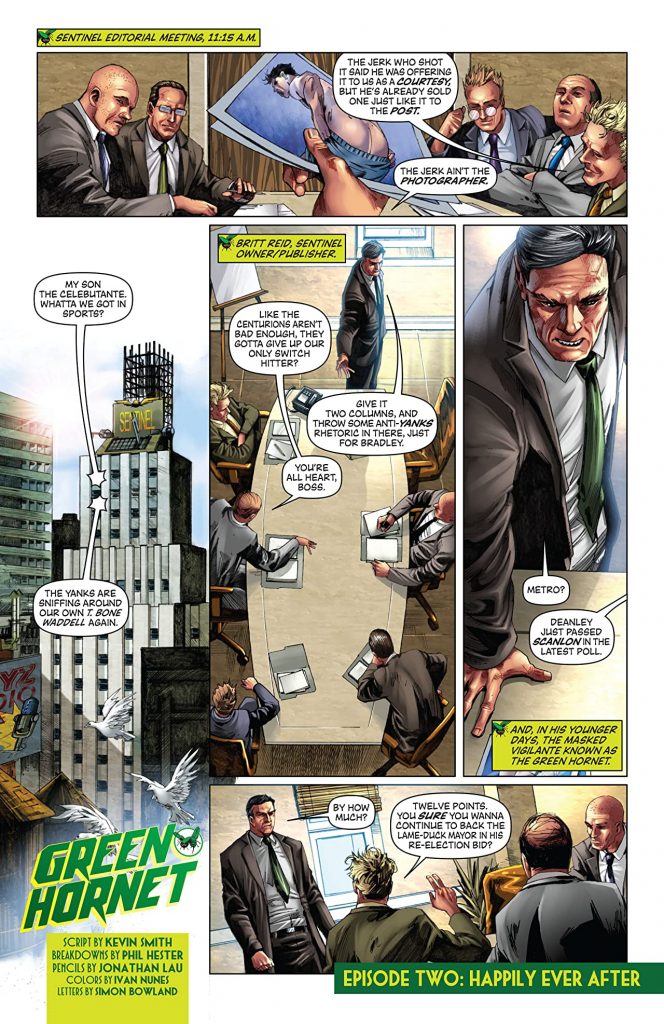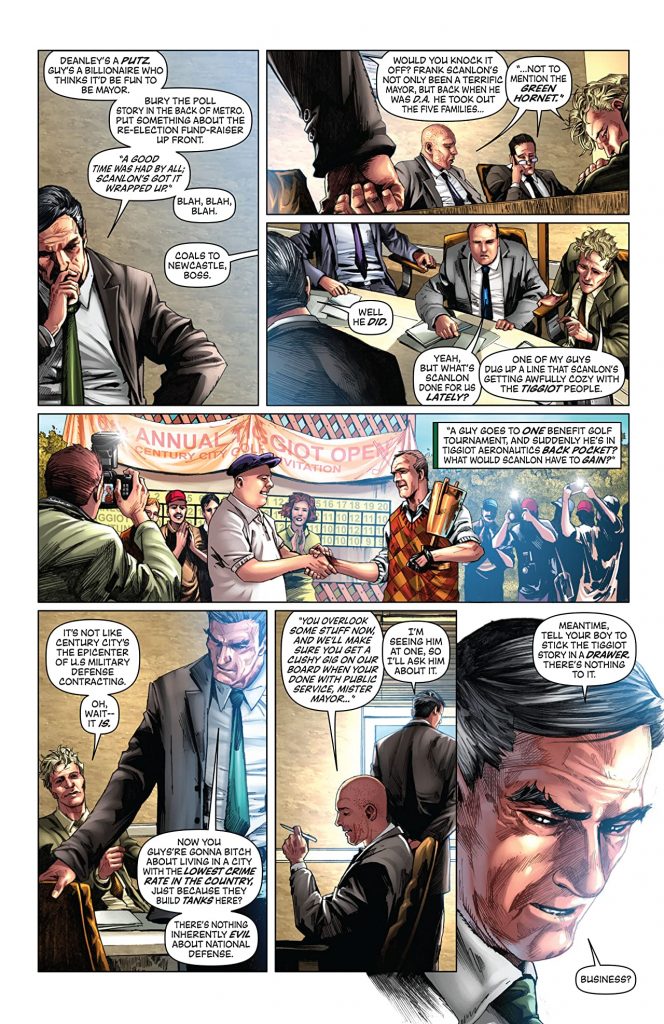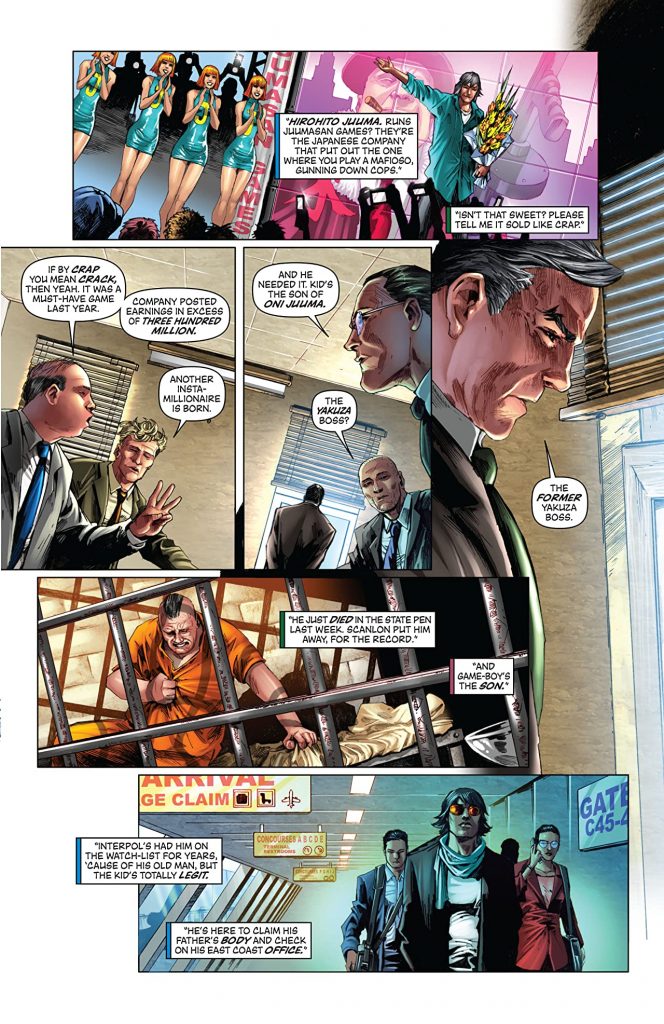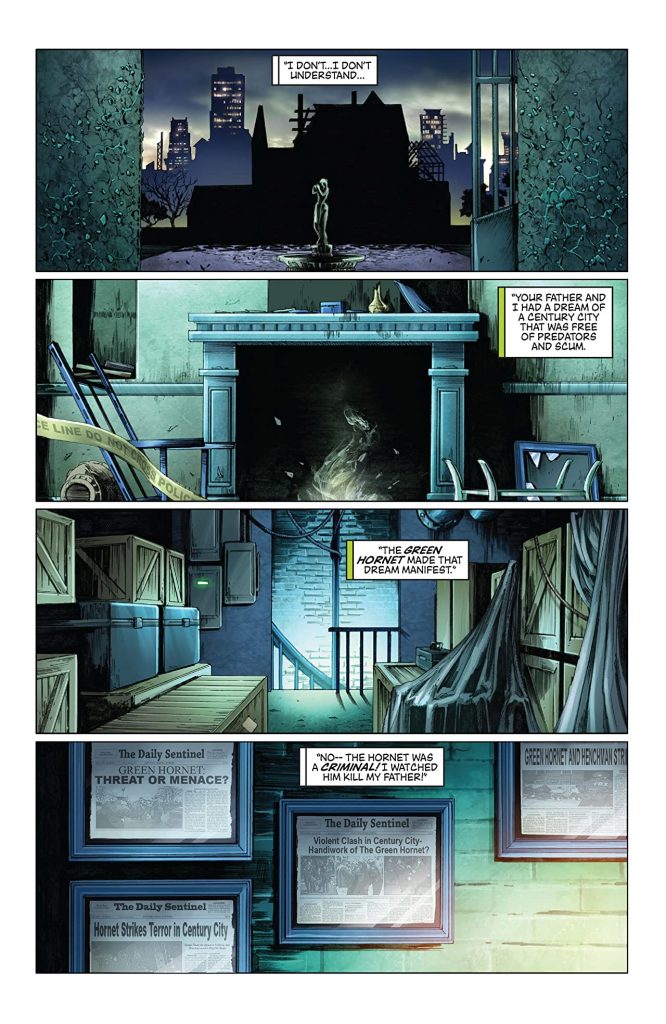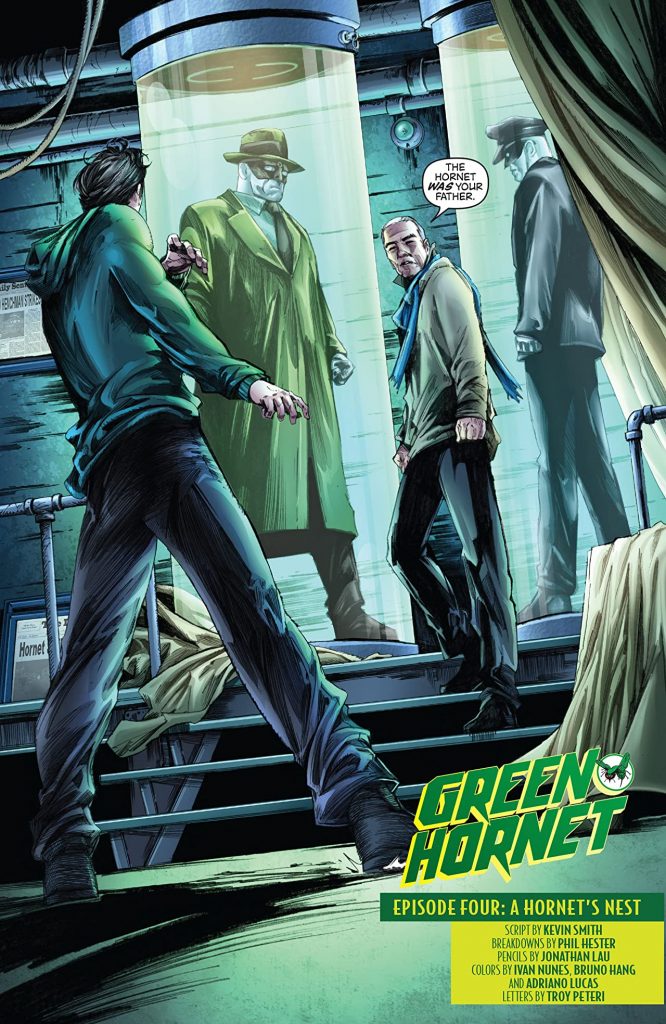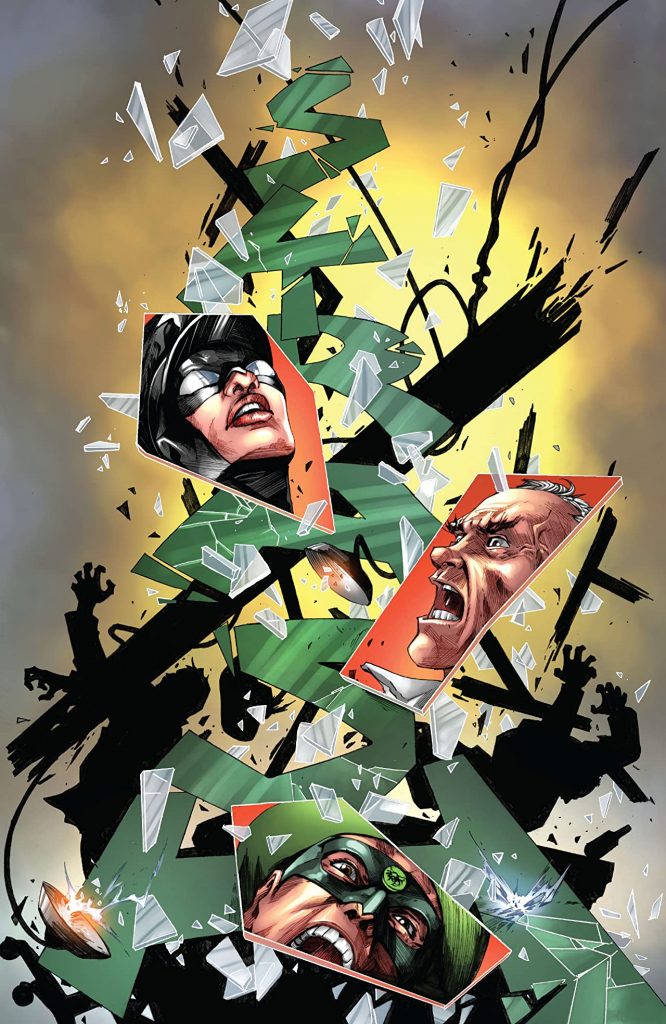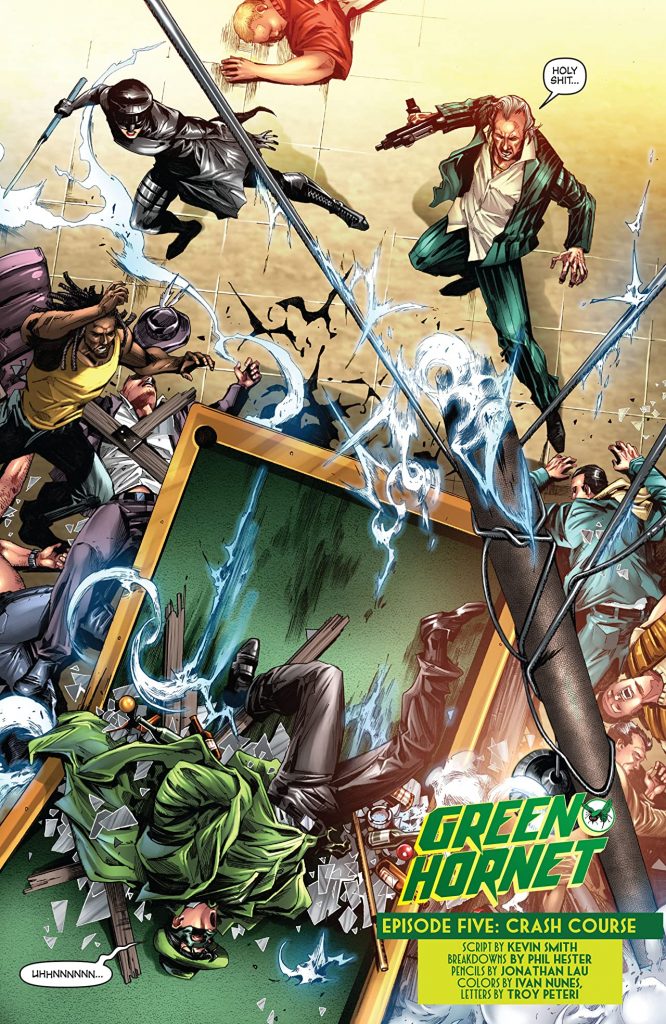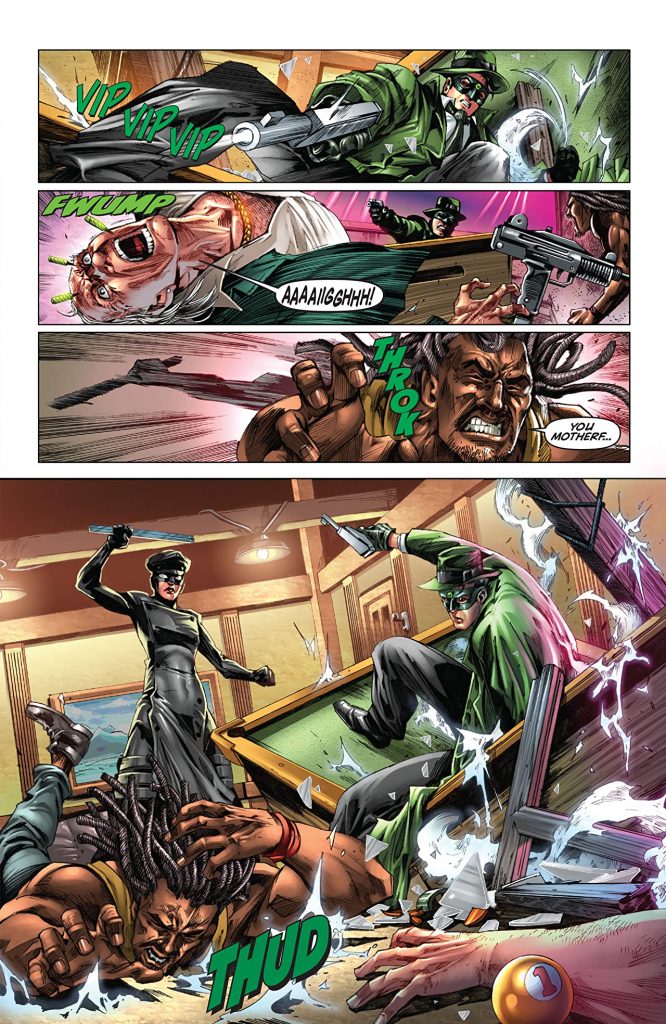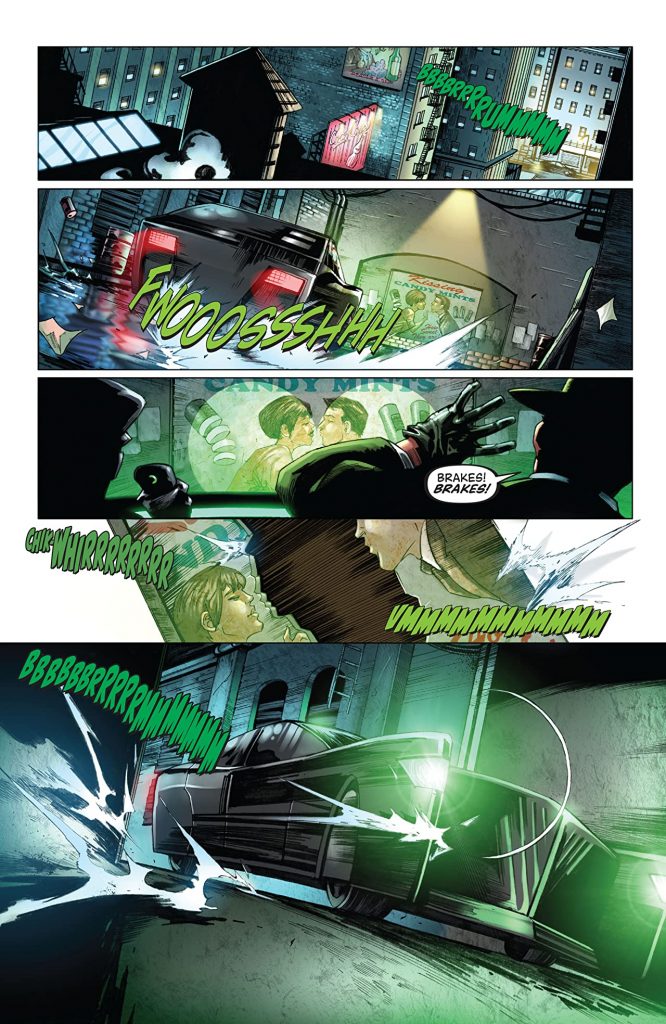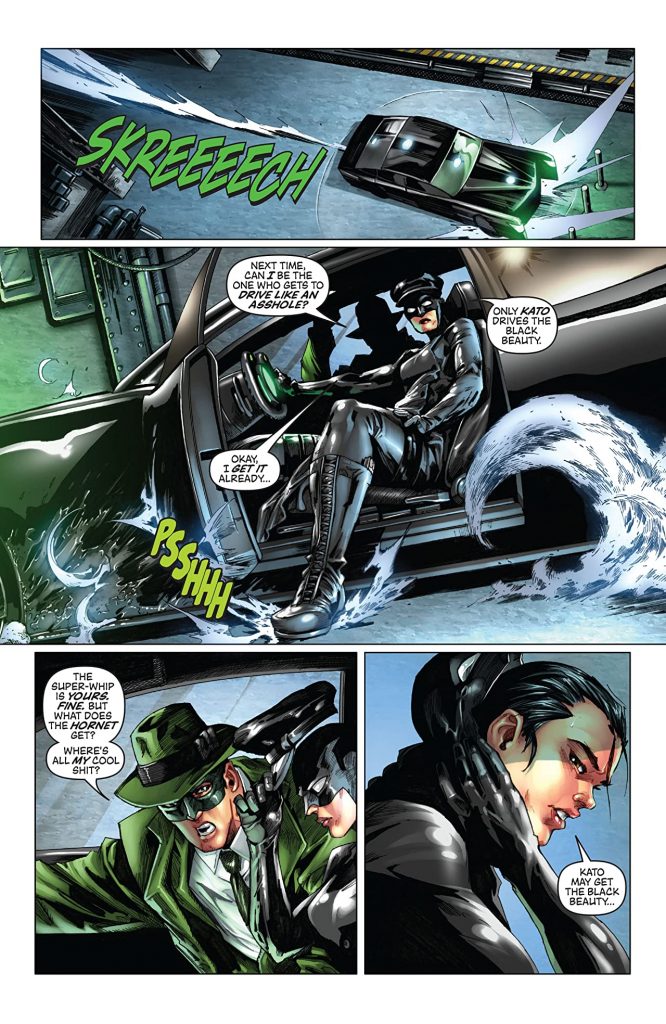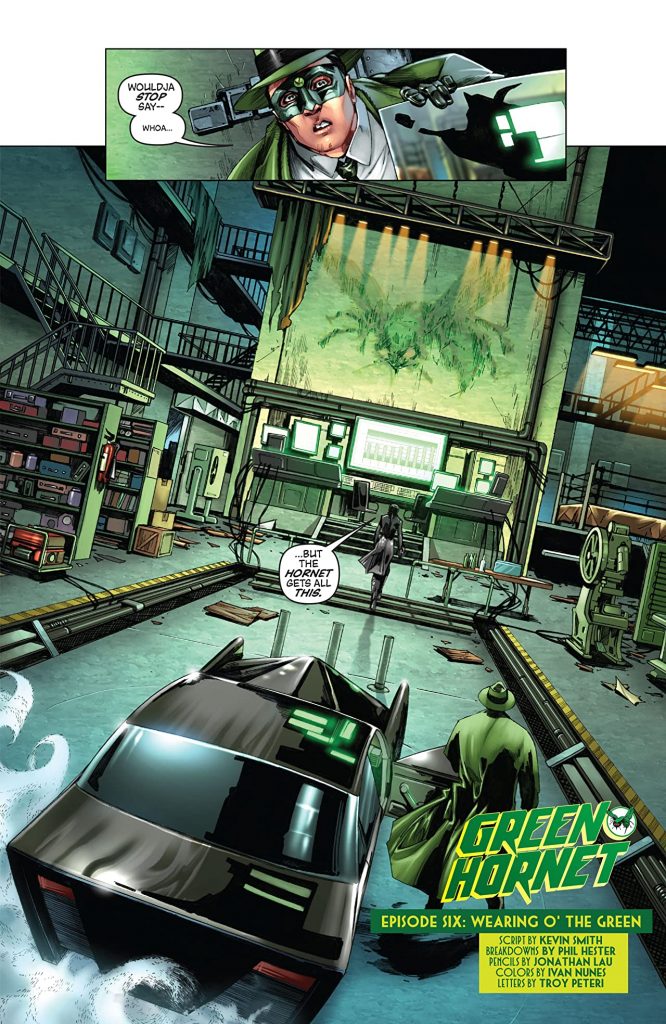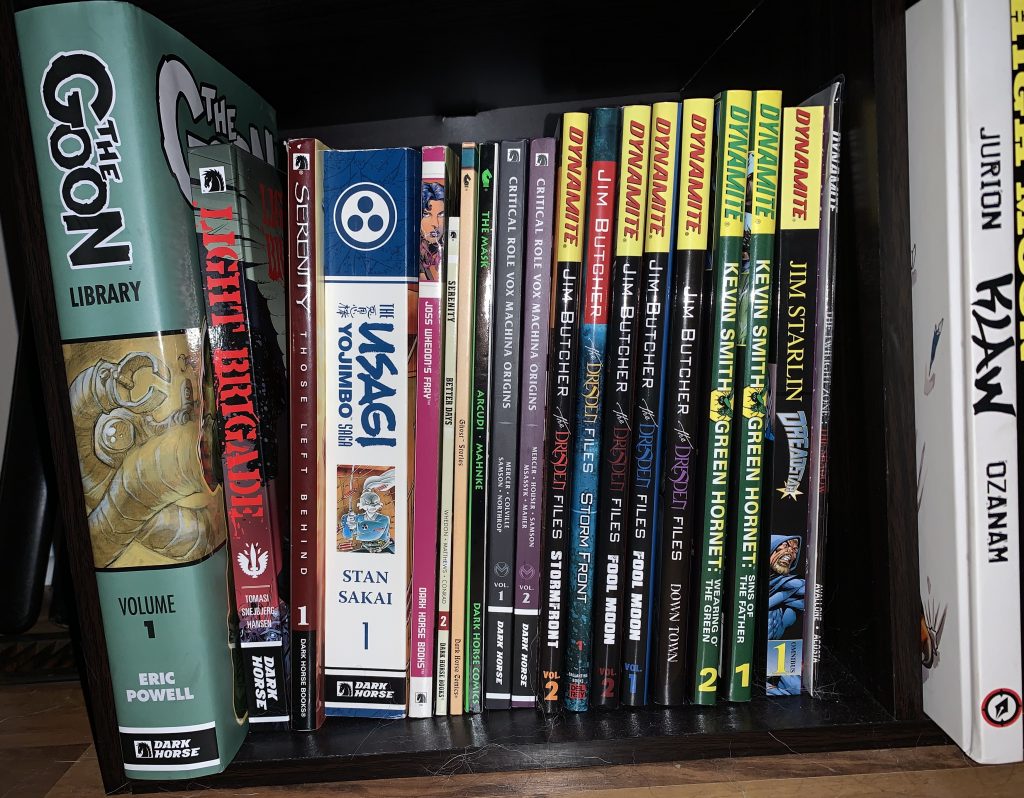
- Kevin Smith’s Green Hornet
- Volume 1: Sins of the Father
- Volume 2: Wearing o’ the Green
- Dynamite Entertainment
- Script by Kevin Smith
- Breakdowns by Phil Hester
- Art by Jonathan Lau
- Colors by Ivan Nunes
- Letters by Troy Peteri
- Collection covers by Alex Ross
- Available pretty much anywhere you wanna buy books…
Since 1936 when he was created by George Trendle & Fran Striker for a series of radio programs, The Green Hornet has fought from the shadows to wage a war on all aspects of crime & corruption. From those early days, the Hornet has gone through many iterations, with movie serials in the 1940’s to a spinoff of the 1966 Batman series, to… I dunno, whatever that 2011 movie was supposed to be. But before that arguably misguided attempt, perpetual renegade film maker and born again vegan, Kevin Smith was tasked to write & direct the Hornet’s return. Smith came up with an updated story- not a reboot- that handed the keys of the Black Beauty over to the children of Britt Reid & Kato. Sadly, Smith opted out of the project after writing the script, doubting his own ability to do justice to the heroes of Century City.
One wonders, if he’s seen the movie that actually came to be, does he regret that decision?
Look, I’m not gonna say that everything Kevin Smith does is solid gold, but it can’t be denied that whatever the man turns his hand to, he does it with a limitless supply of enthusiasm. When it comes to the classic comic book properties that he’s been associated with (Batman, Daredevil, Green Arrow), the other thing he brings to any deal is what might have been missing from the movie that wound up being made in his absence: a deeply rooted, all encompassing, and never-ending love & respect for comics. That spirit is deeply embedded in the script he wrote, which has since- thankfully- been brought to the page by the current publisher of all things pulp, Dynamite Entertainment.
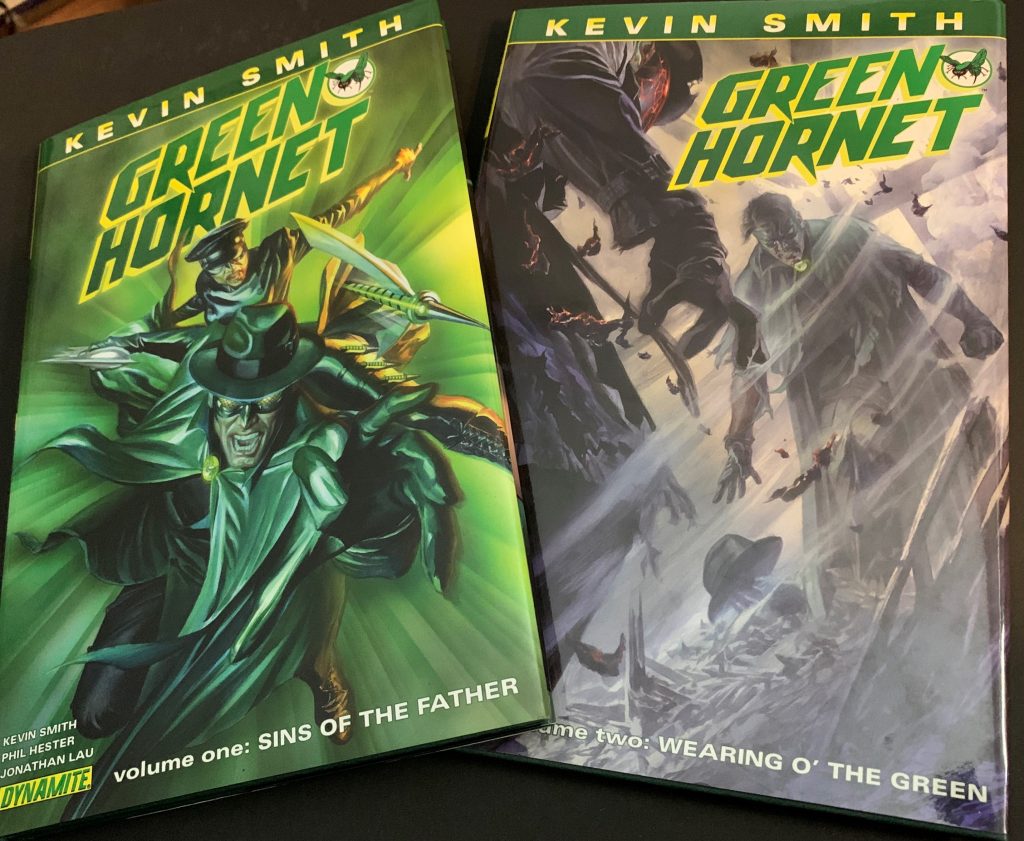
It had been a while since I’d read the two volume story, scripted by Kevin Smith, reworked for the comic book by Phil Hester, & illustrated by Jonathan Lau. Then I found myself listening to the Shelved podcast, and after listening to the discussion between caster Jeremy Meyer & comic writer Joe Kachadourian (Identity Stunt, with which I’m passingly familiar), it got me thinking. Their talk about the ups and downs of Kevin Smith’s Green Hornet got me thinking that I really wanted to revisit this book, and that I just happened to have the hard cover editions sitting on my bookshelf. So I blew the dust off of those books and dove in for a return to the pulpy greatness that was, is, & always will be…
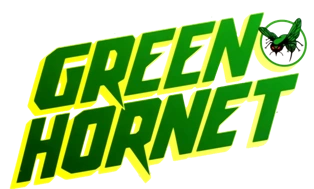
Kevin Smith’s Green Hornet starts with a dip back into the thrilling days of yesteryear as the original Green Hornet & Kato interrupt a meeting of Century City’s criminal bosses. When the dust clears, the evil has been subdued and the two realize that their mission to clean up their city has been accomplished. That done, they turn their eyes toward the purpose behind the mission. For Reid, that was to provide a safe place in which to live with his wife Janet, where they could raise their son without undue worry. For Kato, he was ready to start a life, to find a home in which he could have a family of his own; a thing that he didn’t feel he could do until he’d fulfilled an obligation to his friend Britt.
Jump forward a bit, where we find a young Britt Reid, heir apparent to the legacy of his newspaper owner/editor father, misbehaving in public. Ensuing scandal, blah blah, outrageous behavior, blah. This is all filler to establish a rough relationship between father and son, as we get to the meat of the story. You see, Britt the younger never knew about his father’s alter ego as the Green Hornet, now little more than an urban legend whispered about in back alleys. Having no idea what his father had given up to keep Century City safe, to keep him safe, Britt Jr just knew that he never saw much of his dad when he was growing up. Without that understanding, it was impossible for young Britt to come to get a handle on his stern father’s disapproval for his perceived lack of ambition. When the father pushes, the son pushes back and familial tension builds, waiting for a catalyst to come along to release it.
Enter the Black Hornet, Century City’s newest criminal with grand aspirations and an all too familiar fashion sense.

Kevin Smith’s story runs through its paces, revealing to Britt the truth of his father’s secret life & introducing Mulan Kato, daughter of the original driver of the Black Beauty & partner in crime fighting to the Green Hornet. There are highs and lows, but overall Smith brings a lot of joy to what is basically a tale of legacy, of forging a path out of the shadow of the fathers while honoring their ideals. What Smith has always done very well is establish the relationships between his characters, and letting their personalities show through their interactions. In the first chapter, we can see that Britt & Kato the elder are more than just hero & sidekick. The friendship runs bone deep between these two, and Smith lets it play out on the page rather than resorting to narration to lead readers to the conclusion that they are “good friends”. Despite a few spots that dipped a little too deeply into the realm of goofy (the costume montage I could’ve lived without) and were a little too far removed from the overall tone of the book, it’s the character building that always stands out in Kevin Smith’s writing.
As should be expected & hoped for, given Kevin Smith’s love for the classic comics he grew up with, there are moments of dialogue and story elements that serve up some solid doses nostalgia and respect for the Hornet’s beginnings. The presence of the “working typewriter” on the roof of Reid’s newspaper building is a great nod to the hero’s pulp origins (“You wanted to play the pulp hero. It’s only fitting you die a pulp hero’s death”). Also, during the inevitable training montage where Kato the elder whips Reid the younger into shape, the martial arts icon quotes some of the philosophy of Bruce Lee, who played the character on TV in the sixties (“When your opponent expands, you contract. When he contracts, you expand”). These are just a few of the moments throughout the ten chapter run that show Smith’s regard for his source material, and it all served to get me through some of the rough spots without much more than a rueful shake of the head.
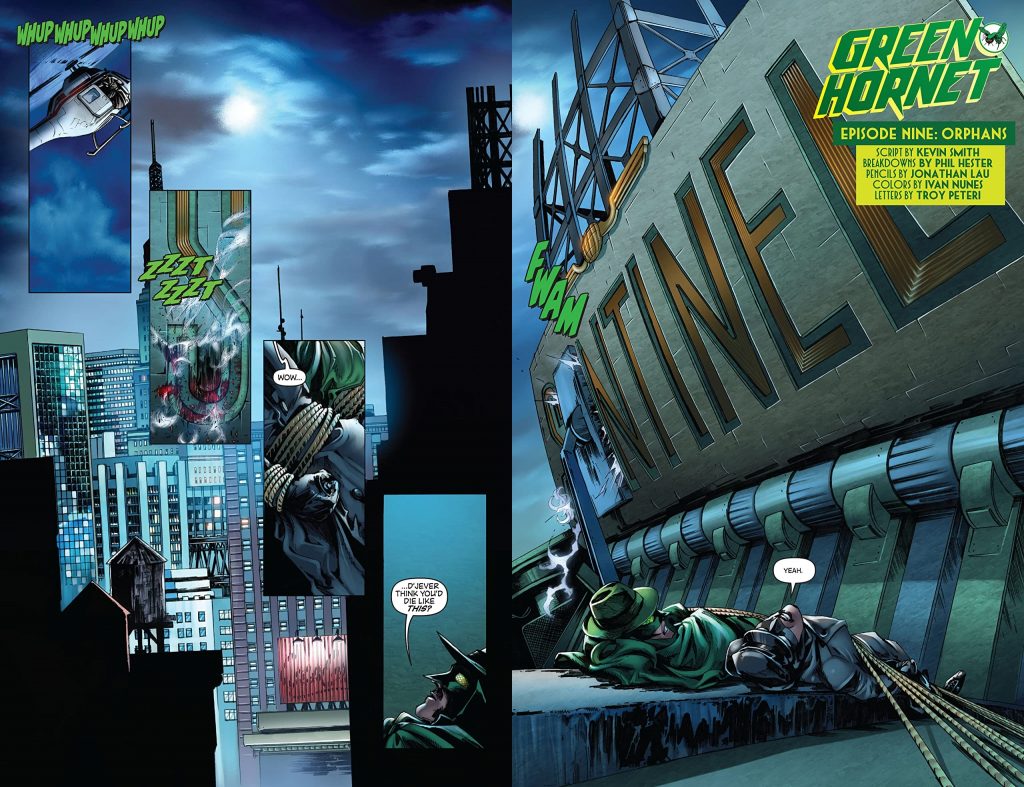
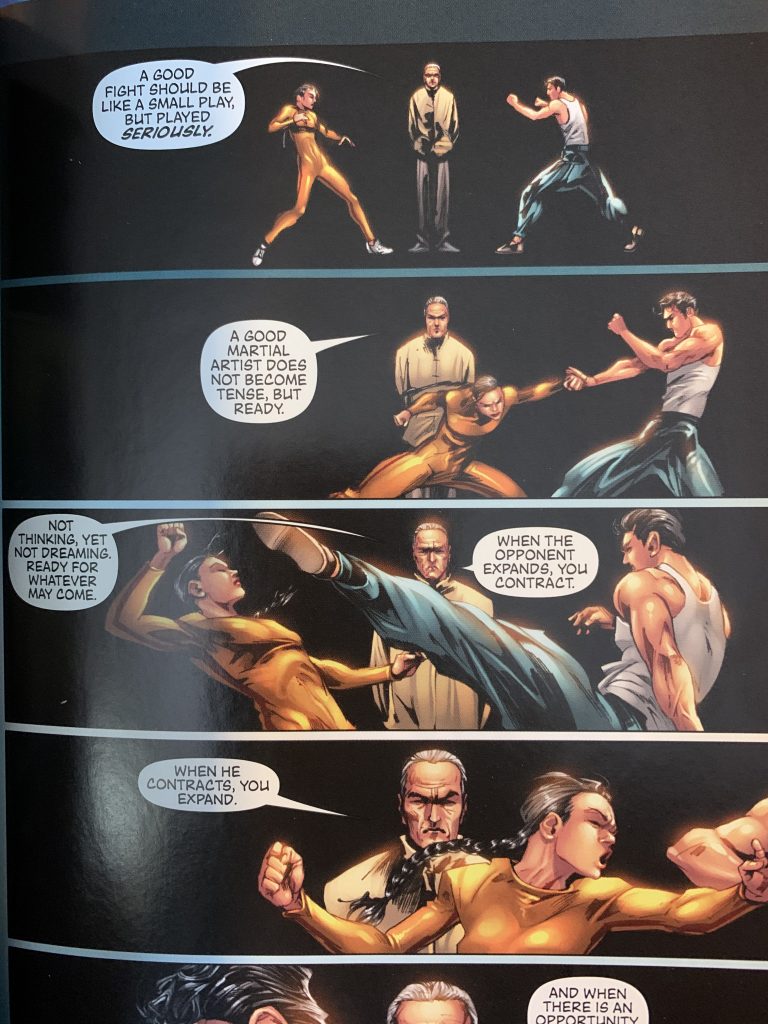
I’m not sure where Phil Hester’s contributions begin or end, but by Kevin Smith’s own admission his script was not comic book ready when Dynamite came a-calling. As he’s no slouch when it comes to putting together a great comic book, either as a writer or an artist, my understanding is that Hester was on hand to make sure the transition from screenplay to comic script went off without a hitch. Whether he worked on breaking down some of the dialogue for the panel, adding narrative boxes to fill in information as needed, or put polish to the fight sequences (another confession from Smith is that he hates scripting fights), Hester’s work on any title is always noteworthy.
Without artwork, a comic really isn’t much of a comic. In that regard, Kevin Smith’s Green Hornet won a lottery with the presence of artist Jonathan Lau & colorist Ivan Nunes. Lau’s characters are always dynamic, ready to jump off of the page even when they’re standing still. When the action starts, his work goes from impressive to outstanding. Any time I see an artist who’s able to capture the more subtle points in martial arts… I don’t know, it just makes me happy. Lau is able to break down a roundhouse kick to its finest details, from chambering the kick to turning the hip over in its execution, and when Kato delivers a knife hand to the side of an enemy’s neck, it chops into meat with bone crunching impact. As to the colors, Nunes takes the bones of Lau’s work and fills them out beautifully. Never straying too far from the requisite greens in his palette, Nunes adds depth and enhances the mood in every scene.
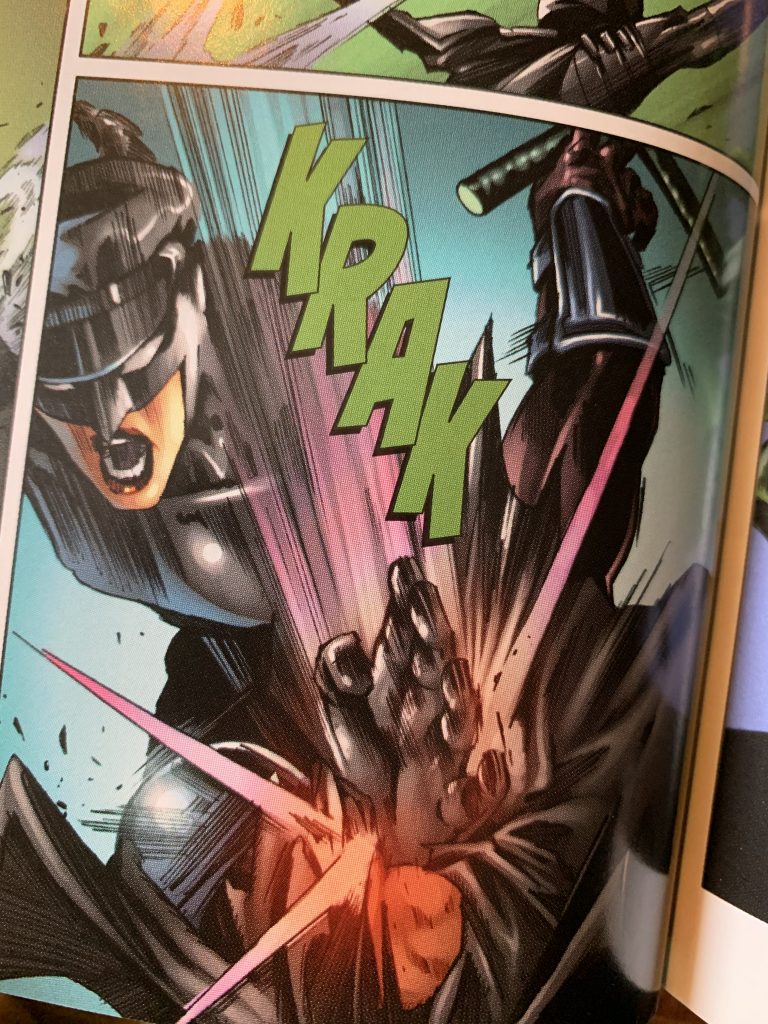
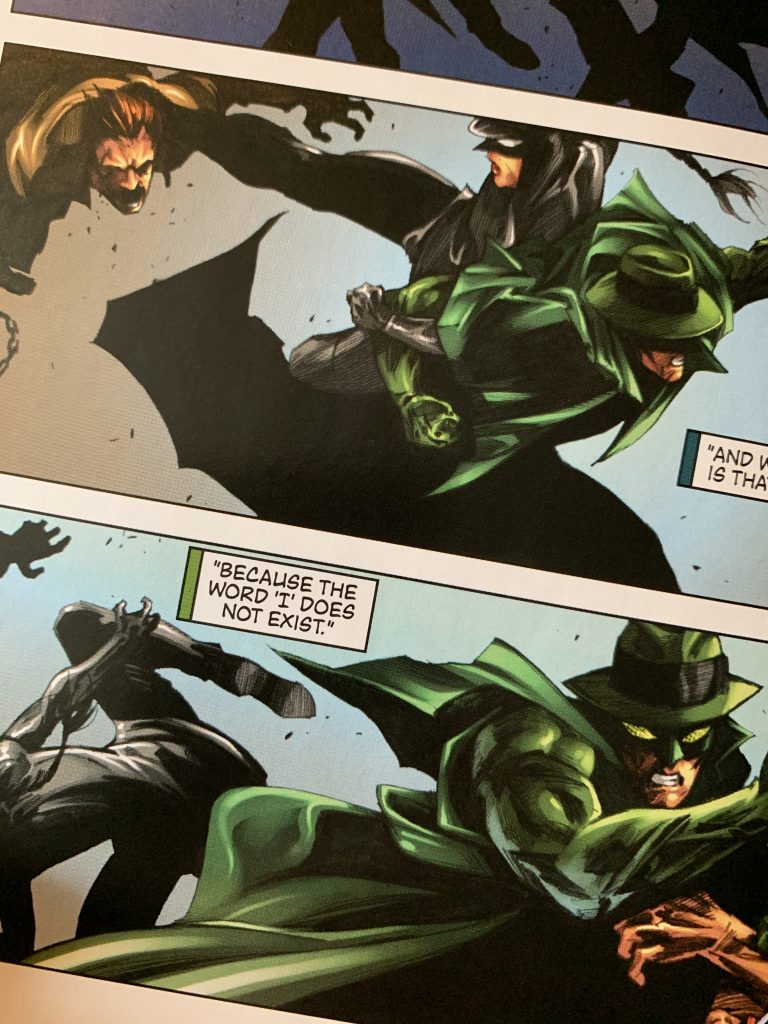
And the lettering… Sure, the dialogue is all pretty straightforward, but the true worth of a good letterer isn’t always in the flair they bring. I’ve seen too many comics get bogged down in over the top lettering and fancy fonts. In Green Hornet, Troy Peteri keeps it fairly simple in the dialogue and text boxes, letting nothing get in the way of the art. But the sound effects… oh holy mother of mercy, the sound effects. Between the fights, the chases, the explosions, and the people being turned to meat paste on the aforementioned giant working typewriter, I don’t think any single effect was ever repeated once in the entire 10 issue run.
Not without hiccups, there are points where the action may have moved too quickly for the page to capture transitions from one panel to the next. Also, as previously stated, there are some points where the tone leans heavily into the View Askew realm of silly happenstance & convenient plot devices to get from point A to B. After this, my fourth… maybe fifth read-through, I can in all honesty say that none of that dulled my enjoyment of this title. I’m not gonna lie, any trip into the realm of classic pulp heroes (Doc Savage, Rocketeer, The Shadow) is going to step well into my wheelhouse as a reader and lover of comics. Still, I know what I like and what I don’t.
I’m not even going to try to assign a “final score” to this one. By now it should be pretty plain where I stand on Kevin Smith’s Green Hornet, and our current scoring metric just doesn’t seem to do it justice. Between the story, interior art, and (oh, did I mention) some absolutely gorgeous covers by Alex Ross (some equally amazing single issue covers by Joe Benitez), this is one that will stay on my bookshelf forever.
Y’know, except for the times that I’m reading it. Again. Cuz it’s awesome.
That’s all…
